Vertical, Crescent and Periareolar Breast Lift Scars: See for Yourself
The golden age for over-the-top, outrageously vulgar breast augmentation has passed—more and more patients nowadays turn to the option of “making the best of what they’ve got”, instead of relying on implants.
An extremely popular option among women who’ve undergone pregnancy or whose breasts have lowered over time, a breast lift removes a portion of the stretched skin and some of the upper fat within the breasts to restore a forward-pointing, youthful appearance.
Breast lifts are popular both among women with smaller and larger breasts.
Despite the allure, many women are worried that breast lifts will do more harm than good, in the form of scarring.
It is the breasts we’re talking about, after all, and nobody wants to walk away from the surgeon’s table with long, visible scars.
The reality is that many women are getting the procedure done, and leave satisfied with the results:
- Not all breast lift procedures leave significant scarring
- Most breast lift scars are easy to hide
- There are things you can do to minimize scarring
CAN YOU AVOID SCARS AFTER BREAST LIFT PROCEDURES?
In short, no. At least, not completely.
Both breast lift and breast reduction procedures require incisions. When the incisions heal, scar tissue forms, creating a highlighted appearance on the skin—the scar.
Should you be worried, though?
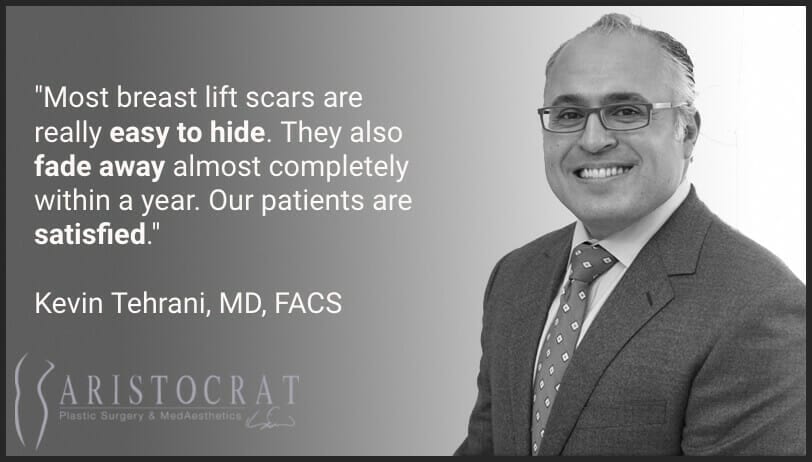
There are several important things to keep in mind:
- Breast lift scars are really easy to hide. The scars will either appear as small incisions on top of your breast (if the vertical “lollipop” technique is chosen) or thin horizontal incisions. Either way, they’re really easy to cover with a bra or a swimsuit.
- Scars fade away with time. Even though the scarring is somewhat permanent, they do fade away with time. Usually, it takes about 1-2 years before the scar becomes barely noticeable. Do not panic if you see any scarring pictures that were taken right after the procedures—most breast lift patients are extremely happy with their appearance as time goes by.
- A lot depends on the scope of the procedure. How much visible scarring is going to remain after the procedure depends on a number of factors, including how much sagging is there, how elastic your skin, and the overall scope of the lift. The general rule of thumb is this: the smaller the procedure, the less noticeable the scars.
- There are things you can do to minimize scars. While we’ll cover this in-depth further in this article, keep in mind that there are preparation and recovery guidelines that can significantly impact how well you heal after your procedure, potentially minimizing the scarring.
- Good surgeons will provide the best “value-for-scar.” Every patient is different, and we celebrate that. Here at Aristocrat Plastic Surgery, we strive to hear every single patient and truly understand their appearance goals. Sometimes, patients who believe a breast lift would be the optimal procedure for them change their minds. Whatever the conclusion, we understand that significant scarring is an unacceptable outcome for most patients.
TYPES OF BREAST LIFT TECHNIQUES PERFORMED
There are many different techniques that plastic and cosmetic surgeons employ to achieve the desired result.
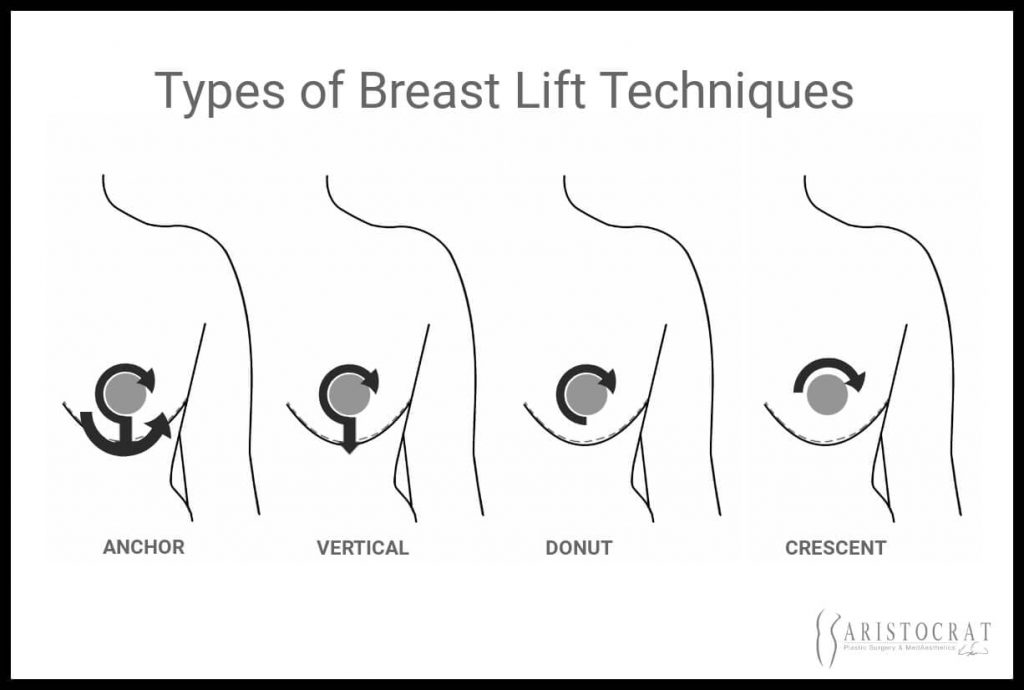
Each of these breast lift techniques are tailored to address specific problems; each of them leave different scars.
Here are the most commonly used breast lift techniques in modern plastic surgery.
SCARLESS BREAST LIFT: A NON-INVASIVE OPTION FOR MINIMAL CORRECTIONS
Main benefits and drawbacks:
- Scarless breast lifts leave no or minimal scars, but are only somewhat effective
- Scarless breast lifts can improve overall appearance only if you’re already satisfied with how your breasts look to an extent
- Scarless breast lifts can help you avoid recovery downtime, but you might not see significant improvement in your breast appearance
- The technique may provide good short-term results, but the skin is likely to stretch over time, returning to its original appearance
As with many plastic surgery procedures, new technology allows us to employ non-invasive techniques that do not leave any scars.
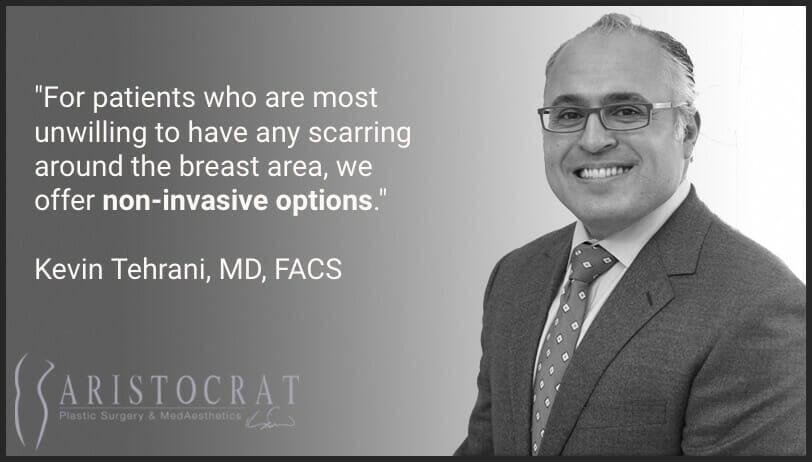
During non-invasive breast lift procedures, two general dynamics are happening:
- The skin above the breast is tightened
- Fat cells underneath the skin are destroyed
This helps achieve a higher, pointier, tighter breast appearance. Since no (or minimal, depending on the specific scarless technique used) incisions are made, no scar is left after the procedure.
The general problem with non-invasive techniques is their effectiveness.
Non-invasive, scarless breast lift techniques cannot compare in their effectiveness to surgical procedures.
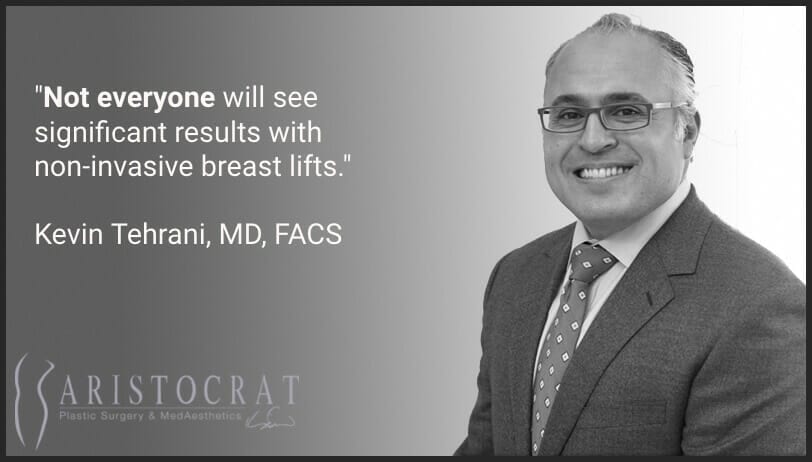
Nevertheless, they may be a good option to consider for patients who:
- Have little sagginess in the breast area. Due to the way non-invasive breast lifts work, excess skin is not removed—instead, the skin is “tightened” using laser-powered technology, and some fat inside the breast is also destroyed permanently to create a tighter look.
- Have relatively proportional breasts. Non-invasive techniques struggle to create big makeovers. Therefore, they’re usually best for patients who are already somewhat happy with the way their breasts look, and are simply looking for minor adjustments.
- Are looking for minor corrections. Light breast lifts with no excess sagginess are best candidates for non-invasive lift techniques.
- Do not want to or cannot undergo a surgical procedure. Not everyone is a good candidate for invasive procedures. Some patients might have a medical history which can cause interactions with the anaesthesia. Others are at an increased risk of a post-surgical infection. Whatever the reason, invasive techniques are not for everyone.
- Prefer to minimize their recovery downtime. Invasive procedures are always followed by a period of recovery and partial immobilization. This means a recovery down-period, which you’ll mostly spend home. Even for the smallest breast lift procedures, you should plan at least 1 week off work, travel and active social events.
- Cannot afford to have any visible scars. Certain professional occupations—such as types of modeling and acting—might refrain patients from having any visible scars, steering them towards non-invasive alternatives. Other candidates may simply prefer the no-scarring option for their own personal sense of self-appeal.
Here are a few pictures of several different “scarless” breast lift procedures:
CRESCENT BREAST LIFT: LIFT YOUR NIPPLE BY AN INCH
Crescent breast lifts:
- Are only effective for smaller breasts with little sagginess
- Are used specifically to “relocate” the nipple
- Rule of thumb: if you want your nipple ±1 inch higher, crescent technique might be right for you
As far as breast lifts go, the crescent technique is extremely specialized: it is only used to “lift” the areola area (the nipple.)
Effective with minor breast sagging issues, the crescent breast lift technique uses only minimal incisions on the top side of the breast. For this reason, only minimal scarring occurs.
The general rule of thumb for the crescent breast lift is this: if the nipple position needs to be raised only by 2-3 cm (0.8-1.2 in) to achieve the optimal breast look, then the patient is considered a good candidate for the crescent breast lift technique.
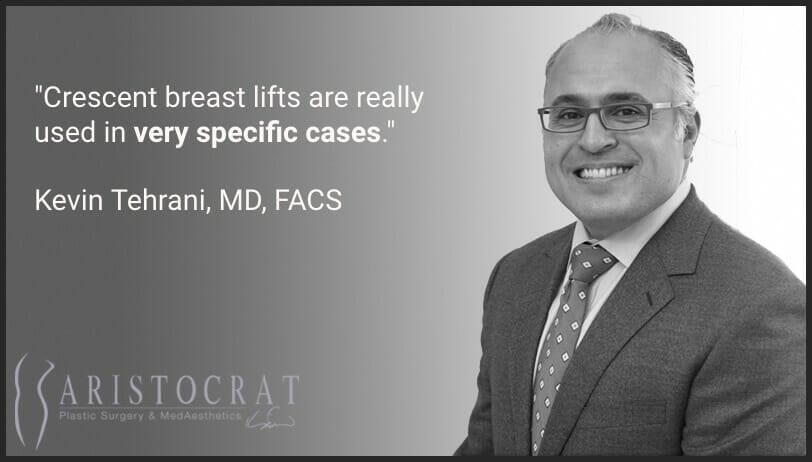
There are a few other criteria that make a good crescent breast lift candidate:
- Combined with breast augmentation. Due to its minimally-invasive nature, the crescent breast technique is often combined with breast augmentation procedures and performed during the same session.
- Small breasts. Since the crescent incision is very small, its transformational abilities are limited. However, patients with smaller breasts can still experience satisfactory results with this particular breast lift technique.
- Little overall sagginess. Some breasts develop in a way that while their “overall” saginess does not go overboard, the nipple is still eventually “driven” south on the breast surface. In these particular cases, crescent breast lift is the ideal procedure for the candidate.
- Nipple “droop.” Related to the previous point, some patients find their nipples drifting “downwards” on their breasts. In qualified hands, the crescent breast lift can help those patients restore their areola (nipple) area back to its “forward” position.
- Minimal sagging. Patients with significant sagging will find other breast lift alternatives much more useful, for several reasons:
- The procedure might achieve significant results. For larger, saggier breasts, the crescent breast lift technique may even be unable to achieve its primary purpose: to “relocate” the nipple.
- Other techniques will achieve a much better overall result. Patients with significant sagginess will simply find other procedures much more aligned with their goals and expectations.
“DONUT” (PERIAREOLAR) BREAST LIFT: ADDRESS MODERATE SAGGING WITH A SINGLE INCISION
With donut breast lifts:
- Only 1 incision is made around the nipple
- These work best with small-medium sized breasts
- Optimal for patients with moderate sagging
Often called the mini-lift, the donut breast lift technique is aimed at patients who have mild drooping: not enough to justify a full-on vertical breast lift, but large enough to render crescent and non-invasive techniques ineffective.
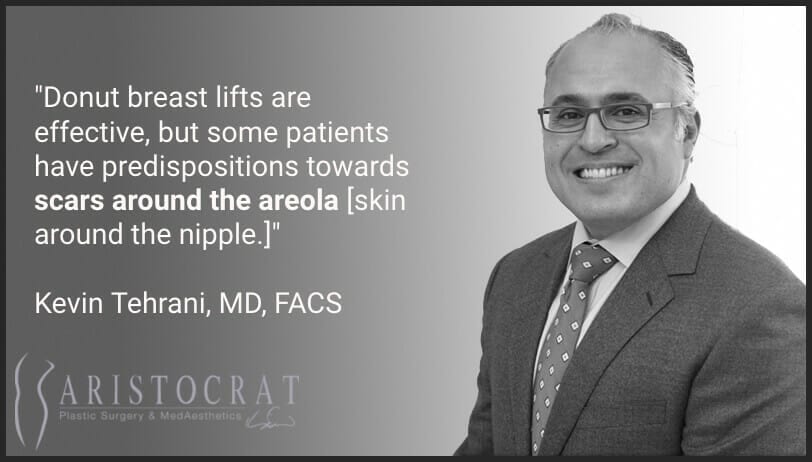
In the medical community, donut lifts are somewhat of a hot topic. Most of it is due to the nature of the scar.
See, the name “donut” comes from the fact that the incision is made around your areola area—around the nipple.
Patient opinions on these types of scars vary significantly.
Some patients are happy to have only one incision for the entire procedure, and consider the periareolar incision scars to be discreet and easy to cover.
Others, however, are not so fond of the technique: they do not like the idea of having a scar around the nipple. They would honestly prefer a larger incision on the bottom of the breast rather than having a scar around the nipple.
Naturally, these scars will fade away with time.
A good candidate for the donut breast lift procedure will:
- Have moderate sagging. To use the Regnault ptosis scale, most donut-breast-lift candidates will have Grade II breast sagging, defined as “The nipple is located below the inframammary fold [the place where the bottom of your breast skin meets the chest] but higher than most of the breast tissue hangs.”
- Do not mind the “around-the-nipple” scar. It is truly an individual preference for every patient. Below you’ll see pictures of what donut breast lift scars might look like. Every patient will have their own attitude towards this type of scarring—it is our job to inform all candidates of what they might expect.
- Do not want a highly invasive procedure. If, for any reason, the patient prefers a less invasive technique, periareolar (donut) is the way to go. Within the spectrum of breast lift techniques, donut procedures have the potential to deliver most significant results with minimum overall scarring.
- Have small-medium sized breasts. While the periareolar incision definitely offers more options for the surgeon, the technique is still most effective with small-to-medium sized breasts.
The major advantage of the donut technique is that only one incision is required.
This produces less “overall” scarring, reduced the chances of an infection, and speeds up the recovery.
LOLLIPOP (VERTICAL) VS. ANCHOR LIFT: TWO INVASIVE, MAJOR BREAST LIFT TECHNIQUES
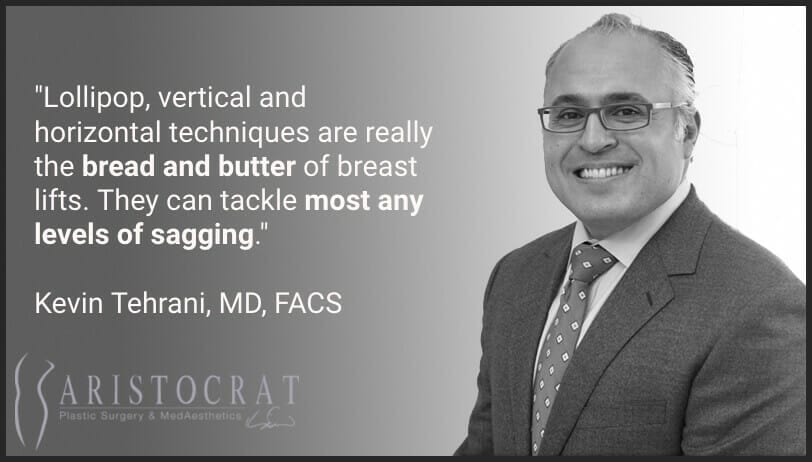
For patients with significant breast sagginess and medium-to-large breasts, two most commonly used techniques are lollipop and anchor lifts.
Here are a few major differences between the two types of breast lifts:
- The lollipop technique only re quires two incisions, while the anchor technique requires three incisions
- The lollipop technique is less invasive than the anchor technique
- The lollipop lift produces less visible scarring than the anchor technique
Different surgeons have contradicting opinions on which of the two techniques to use.
In essence, the anchor breast lift is the same as vertical lift, with an additional horizontal incision made under the breast.
While only a qualified surgeon will be able to give you an individual recommendation that would enable you to achieve the best possible results, there are a few general guidelines regarding which type of breast lift is best for you:
- Patients with moderate-to-high sagging will likely suffice with the vertical lift, while patients with large-to-extreme sagging will go for the anchor lift
- Patients with small-to-moderate breasts will definitely be much better candidates for the lollipop lift rather than patients with large breasts, who are good candidates for the anchor lift
- Patients who prefer a quicker, smaller, less invasive procedure will choose the vertical lift over the anchor lift
A simplified surgery decision making rule also reflects which type of breast lift might best help you achieve your goals:
- If most of the excess skin is located centrally (around the nipple), the donut incision might suffice in achieving expected results
- If the excess skin is to be removed horizontally (to the sides of the nipple), then the vertical (lollipop) incision will produce the most dramatic results
- If the excess skin spans in all directions, then the full anchor lift will be needed to achieve significant change
HOW TO RECOVER QUICKLY AND MINIMIZE SCARRING
Luckily, even if you go for the biggest, most incisive breast lift procedure, there are things you can do to heal properly and minimize scarring.
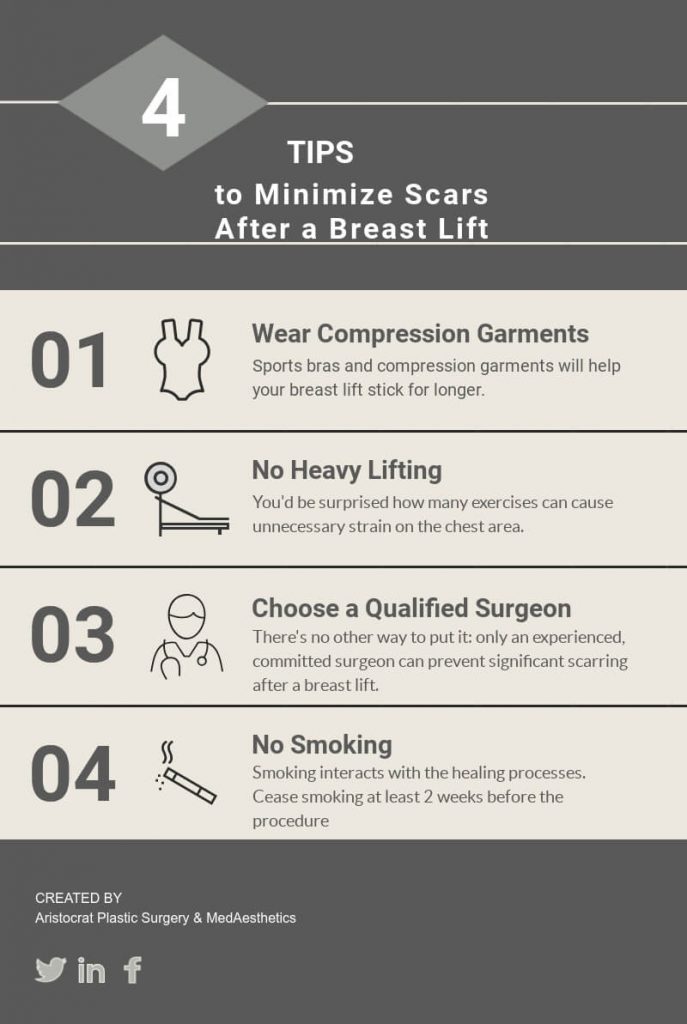
CHOOSE AN EXPERIENCED, QUALIFIED BOARD-CERTIFIED SURGEON YOU TRUST
While this goes without saying, choosing the right surgeon for the job is the most important factor in how well your scars will heal.
The obvious reason is the knowledge and skill in the procedures. An experienced surgeon use a technique that will minimize the scarring and help you achieve the desired appearance.
But there are other, more subtle differences between surgeons—ones that we don’t like to talk about often.
Some practices will take on patients despite whether they’re a good candidate for the particular procedure or not—they will simply try to “sell” them the most expensive procedure, even at a cost of a possible complication or severe scarring.
While not all of those types of surgeons are necessarily ill-minded, some will simply not have the “luxury” to say no to a patient—even if the procedure could clearly harm them.
That is why we always suggest talking to at least several different plastic surgeons and evaluate their attitudes and level of commitment.
Signs of a good plastic surgeon include:
- Genuine interest in your goals and expectations
- Thorough interest in your medical history
- Honest, critical opinion about what types of procedures would work best for you
- Transparency in talking about previous patient cases and experience
- Patience and calmness—avoid surgeons who seem overworked and in a rush
WEARING COMPRESSION GARMENTS AND SPORTS BRAS
Generally, we recommend some type of compression apparel after all invasive procedures, as they help reduce the swelling around the incision site, speeding up recovery.
While under slight pressure, the lymphatic system can better flush out fluid and tissue buildups underneath the skin that form frequently after an invasive procedure.
If untreated, these tissues can morph into small lumps, causing fibrosis, a condition that could cause bruising and swelling to occur.
With breast lift reduction, however, there is an important additional benefit to compression garments and sports bras.
Since the very nature of a breast lift procedure involves removing a part of the saggy skin on the upper side of the breast, it is important not to stretch out the remaining skin before the incision heals fully. Otherwise, you might simply reverse the effects of your breast lift.
NO EXERCISE, HEAVY LIFTING FOR A WEEK
Be extremely cautious about your activities throughout several weeks after your breast lift procedure.
Straining your muscles and ligaments in the chest area is one of the more common post-surgical complications.
While patients know better than to straight-up stretch their chest area, they sometimes engage in other activities, which they think do not involve the chest muscles.
In reality, many lifting exercises involve stretching of the chest at least to an extent, and should be avoided.
Cardio, while not threatening to strain your muscles, can slow down the healing of the incisions due to natural movement, and should be limited as well.
The general rule of thumb is this: anything that makes you sweat should be avoided for at least a couple of weeks.
Based on your individual procedure and body parameters, your surgeon will prescribe a more detailed exercise and activity plan.
NO SMOKING FOR A MONTH
You’ve probably heard this countless times, but smoking is really, really bad for you during the recovery period.
The main reason why surgeons strictly forbid smoking for several weeks is because it significantly interferes with the healing processes. Which means, your scars are likely to be worse when you smoke.
What is more, sub-optimal healing may lead to complications, such as infection, which may cause worse problems than just a small scar.
If you think you can’t refrain from cigarettes for that long, we’d recommend to reconsider going under the knife, or exploring the non-invasive options.
CAN YOU GET BREAST LIFT SCARS REMOVED LATER ON?
At the current state of technology, there are no 100% reliable ways at the moment that could guarantee a safe and consistent removal of the scars.
There are a couple of highly promising techniques that show significant potential in removing various types of scars—involving ones left after a breast lift procedure.
Punch grafting and tissue stretching are among the most commonly used techniques today.
However, we must say that these techniques are aimed at severe, highlighted scars—typical to severe trauma, not delicate surgical incisions.
Properly done breast lifts leave nothing but barely noticeable lines behind. Even then, these lines tend to lose color and fade away in a matter of months.
FINAL VERDICT: DON’T WORRY ABOUT BREAST LIFT SCARS
We understand that it might be a little daunting—the prospect of long scars stretching halfway across your breasts.
In reality, however, these scars are barely visible and rarely present any discomfort to our patients.
Most of the time, scars fade away almost completely within a year or two, and our patients stop noticing them.
Even if they are somewhat noticeable in front of the mirror—they’re really easy to hide with a sports bra or a swimsuit, so you’ll be covered even when you’re at the beach.

